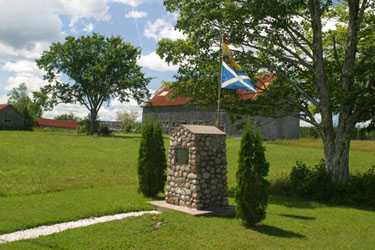

Elliott, Bruce, 2004-2005: Emigrant Recruitment by the New Brunswick Land
Company: The Pioneer Settlers of Stanley and Harvey.********************************************************************************
Craigs's example probably convinced other Northumbrians to make the journey to Harvey in succeeding years, but few enough did so. The reasons why do not relate entirely to the successful promotion of alternative destinations. The deficiencies of the settlement itself, and of the colonial administration, also played a part. The best description we have of the Harvey Settlement comes from the pen of a lecturer in chemistry and mineralogy at the University of Durham who visited there in 1849. James F.W. Johnston had been invited to New Brunswick by the House of Assembly to report upon the agricultural potential of the various counties while on a longer tour of the eastern United States. Though he found Harvey an exception to "the general poor character of the land", even there "the cultivated land ... lies on a succession of low ridges, between which cedar-swamps of greater or lesser extent intervene, and interfere both with regular clearing and cultivation, and with the continuity of farms". The immigrants of 1837 were by then "becoming straitened for room. They complain bitterly that all the good land within immediate reach has been granted to speculators".(120) Indeed, the settlers had petitioned the House of Assembly as early as 1840, complaining of an unimproved tract granted to Beverley Robinson, Esq. on the St Andrew's Road.(121) By the time of Johnston's visit, a second tier of lots had been taken up behind the first farms along the road, and in 1850 a 1000-acre tract on Oromocto Lake granted to Capt. John Campbell had been resurveyed and was being taken up by later arrivals from the Borders, the Rutherfords and Swans first among them. This was the beginning of the Tweedside settlement. Other late arrivals, and members of the second generation of the Cornelius party, would also in time obtain lands on the 1,500-acre Simonds and Beauchant tracts that straddled the road between Tweedside and Harvey.
Medium sized pop up image
700 X 467, 72 dpi, 150 kFull sized pop up image
3072 X 2048, 180 dpi, 3951 kThe Tweedside cairn was erected in 1950 on the shores of Oromocto Lake to commemorate the centenary of a settlement of later arrivals from the Scottish side of the border. They did not, however, constitute a single party that arrived in that year. Source: Tim Patterson (2005 Images)
Medium sized
pop up image
700 X 552,
72 dpi, 157 kFull sized
pop up image
1537 X 1212,
180 dpi, 1542 k
Johnston noted that "behind the second tier of farms are extensive carriboo plains and pine-swamps as far as the Magadavic Lake; but, exploring in search of good land, the young pioneers of the settlement have discovered a tract of rich hardwood land in the midst of the wilderness beyond this lake, to which there is at present no access for want of roads, and no facility of settlement, because of its present remoteness from all human habitations. It is by such explorations, the results of natural expansion, that the better lands are discovered, and the means of successful extension afforded to the families of the older settlers." The lack of road access was decisive, however, and settlement in Harvey continued to move back onto less attractive lands in the third and fourth tiers of lots.
_________________________________________________________________________
(120) Johnston, Notes on North America, II, 168-78. On his purpose, see Report on the Agricultural Capabilities of the Province of New Brunswick (Fredericton: J. Simpson, 1850), CIHM no. 43053.
(121) Journal of the House of Assembly of New Brunswick, 1840, p. 93. My thanks to Jocelean Swan Hall for this reference.

